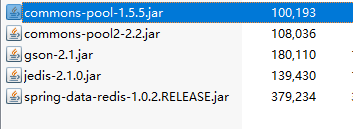博主在上个项目中使用了redis,开始使用的jedisPool连接池的方式进行整合,发现这样是不安全,调研了一下,选择了设置redis密码重新整合,总结经验如下:
1)导入Spring-redis的jar具体如下:

2)配置Spring-redis.xml
<?xml version="1.0" encoding="UTF-8"?>
<beans xmlns="http://www.springframework.org/schema/beans"
xmlns:xsi="http://www.w3.org/2001/XMLSchema-instance" xmlns:mvc="http://www.springframework.org/schema/mvc"
xmlns:context="http://www.springframework.org/schema/context"
xmlns:aop="http://www.springframework.org/schema/aop" xmlns:tx="http://www.springframework.org/schema/tx"
xsi:schemaLocation="http://www.springframework.org/schema/beans
http://www.springframework.org/schema/beans/spring-beans-3.2.xsd
http://www.springframework.org/schema/mvc
http://www.springframework.org/schema/mvc/spring-mvc-3.2.xsd
http://www.springframework.org/schema/context
http://www.springframework.org/schema/context/spring-context-3.2.xsd
http://www.springframework.org/schema/aop
http://www.springframework.org/schema/aop/spring-aop-3.2.xsd
http://www.springframework.org/schema/tx
http://www.springframework.org/schema/tx/spring-tx-3.2.xsd ">
<!-- 连接池配置 -->
<bean id="poolConfig" class="redis.clients.jedis.JedisPoolConfig">
<!-- 最大连接数 -->
<property name="maxActive" value="30" />
<!-- 最大空闲连接数 -->
<property name="maxIdle" value="10" />
<!-- 每次释放连接的最大数目 -->
<property name="numTestsPerEvictionRun" value="1024" />
<!-- 释放连接的扫描间隔(毫秒) -->
<property name="timeBetweenEvictionRunsMillis" value="30000" />
<!-- 连接最小空闲时间 -->
<property name="minEvictableIdleTimeMillis" value="1800000" />
<!-- 连接空闲多久后释放, 当空闲时间>该值 且 空闲连接>最大空闲连接数 时直接释放 -->
<property name="softMinEvictableIdleTimeMillis" value="10000" />
<!-- 获取连接时的最大等待毫秒数,小于零:阻塞不确定的时间,默认-1 -->
<property name="MaxWait" value="15000" />
<!-- 在获取连接的时候检查有效性, 默认false -->
<property name="testOnBorrow" value="true" />
<!-- 在空闲时检查有效性, 默认false -->
<property name="testWhileIdle" value="true" />
</bean>
<!-- redis服务器中心 -->
<bean id="connectionFactory" class="org.springframework.data.redis.connection.jedis.JedisConnectionFactory" >
<property name="poolConfig" ref="poolConfig" />
<!-- 端口号-->
<property name="port" value="6379" />
<!-- host-->
<property name="hostName" value="172.16.30.73" />
<!-- redis密码-->
<property name="password" value="123456" />
<property name="usePool" value="true"></property>
<property name="timeout" value="20000" ></property>
</bean >
<bean id="redisTemplate" class="org.springframework.data.redis.core.RedisTemplate" >
<property name="connectionFactory" ref="connectionFactory" />
<property name="keySerializer" >
<bean class="org.springframework.data.redis.serializer.StringRedisSerializer" />
</property>
<property name="valueSerializer" >
<bean class="org.springframework.data.redis.serializer.JdkSerializationRedisSerializer" />
</property>
</bean >
<!-- 将redisTemplate注入redisSession -->
<bean id="redisSession" class="com.custle.webutil.RedisSession">
<property name="redisTemplate" ref="redisTemplate"/>
</bean>
</beans>3)配置Redis会话工具类
需要声明一点,Static变量使用Spring注入,Static变量的set方法不能加上static修饰。
package com.custle.webutil;
import java.io.ByteArrayInputStream;
import java.io.ByteArrayOutputStream;
import java.io.Closeable;
import java.io.ObjectInputStream;
import java.io.ObjectOutputStream;
import java.io.Serializable;
import java.io.UnsupportedEncodingException;
import java.util.ArrayList;
import java.util.HashMap;
import java.util.List;
import java.util.Map;
import java.util.concurrent.TimeUnit;
import javax.annotation.PostConstruct;
import javax.annotation.Resource;
import org.springframework.beans.factory.annotation.Autowired;
import org.springframework.context.ApplicationContext;
import org.springframework.context.support.ClassPathXmlApplicationContext;
import org.springframework.data.redis.core.RedisTemplate;
import org.springframework.data.redis.core.ValueOperations;
import com.custle.vo.info.UserInfoVO;
public class RedisSession {
private static ApplicationContext context;
private static RedisTemplate<Serializable, Object> redisTemplate;
private static int validTime = 60*30; //单位秒
/*static {
// 加载配置文件
context = new ClassPathXmlApplicationContext("applicationContext-redis.xml");
redisTemplate = (RedisTemplate<Serializable, Object>) context.getBean("redisTemplate");
}*/
public RedisTemplate<Serializable, Object> getRedisTemplate() {
return redisTemplate;
}
//spring设置注入redisTemplate
public void setRedisTemplate(RedisTemplate<Serializable, Object> redisTemplate) {
RedisSession.redisTemplate = redisTemplate;
}
public static void setAttribute(String token, String name, Serializable value) throws UnsupportedEncodingException {
ValueOperations<Serializable, Object> operations = redisTemplate
.opsForValue();
Object obj = operations.get(token);
Map<String, Serializable> session;
if(obj == null){
session = new HashMap<String, Serializable>();
}else{
session = (Map<String, Serializable>) obj;
}
session.put(name, value);
operations.set(token, session);
redisTemplate.expire(token, validTime, TimeUnit.SECONDS);
//返回连接
}
public static Object getAttribute(String token, String name) throws UnsupportedEncodingException {
ValueOperations<Serializable, Object> operations = redisTemplate
.opsForValue();
Object obj = operations.get(token);
Map<String, Serializable> session = (Map<String, Serializable>) obj;
if (null != session) {
//若存在,延长有效期
redisTemplate.expire(token, validTime, TimeUnit.SECONDS);
return session.get(name);
}
return null;
}
/**
* 一次取多个值
* @param token
* @param names
* @return
* @throws UnsupportedEncodingException
*/
public static Map<String,Serializable> getMap(String token) throws UnsupportedEncodingException {
ValueOperations<Serializable, Object> operations = redisTemplate
.opsForValue();
Object obj = operations.get(token);
Map<String, Serializable> session = (Map<String, Serializable>) obj;
if (null != session) {
//若存在,延长有效期
redisTemplate.expire(token, validTime, TimeUnit.SECONDS);
return session;
}
return null;
}
/**
* 批量存
* @param token
* @param name
* @param value
* @throws UnsupportedEncodingException
*/
public static void setMap(String token,HashMap<String, Serializable> map) throws UnsupportedEncodingException {
ValueOperations<Serializable, Object> operations = redisTemplate
.opsForValue();
Object obj = operations.get(token);
Map<String, Serializable> session;
if(obj == null){
session = new HashMap<String, Serializable>();
}else{
session = (Map<String, Serializable>) obj;
}
session.putAll(map);
operations.set(token, session);
redisTemplate.expire(token, validTime, TimeUnit.SECONDS);
}
public static void logout(String token) throws UnsupportedEncodingException {
ValueOperations<Serializable, Object> operations = redisTemplate
.opsForValue();
// 如果存在这个key 则删除此条数据
if (redisTemplate.hasKey(token)) {
redisTemplate.delete(token);
}
}
public static void setAttribute(String token, String name, Serializable value, int timeOut) throws UnsupportedEncodingException {
ValueOperations<Serializable, Object> operations = redisTemplate
.opsForValue();
Object obj = operations.get(token);
Map<String, Serializable> session;
if(obj == null){
session = new HashMap<String, Serializable>();
}else{
session = (Map<String, Serializable>) obj;
}
session.put(name, value);
// 保存到redis
operations.set(token, session);
redisTemplate.expire(token, timeOut, TimeUnit.SECONDS);
//redisTemplate.expire(token, validTime, TimeUnit.SECONDS);
//返回连接
}
/**
* 设置普通的redis缓存(不带session)
* @param key
* @param value
* @param timeOut
* @throws UnsupportedEncodingException
*/
public static void setCommonAttribute(String key, Object value, int timeOut) throws UnsupportedEncodingException {
ValueOperations<Serializable, Object> operations = redisTemplate
.opsForValue();
// 保存到redis
operations.set(key, value);
redisTemplate.expire(key, timeOut, TimeUnit.SECONDS);
//返回连接
}
/**
* 设置存入Oject的redis缓存(不带session)
* @param key
* @param value
* @param timeOut
* @throws UnsupportedEncodingException
*/
public static void setObjectAttribute(String key, Object value, int timeOut) throws UnsupportedEncodingException {
ValueOperations<Serializable, Object> operations = redisTemplate
.opsForValue();
// 保存到redis
operations.set(key, value);
redisTemplate.expire(key, timeOut, TimeUnit.SECONDS);
//返回连接
}
public static Object getObjectAttribute(String key) throws UnsupportedEncodingException {
ValueOperations<Serializable, Object> operations = redisTemplate
.opsForValue();
// 保存到redis
return operations.get(key);
//返回连接
}
public static Object getCommonAttribute(String key) throws UnsupportedEncodingException {
ValueOperations<Serializable, Object> operations = redisTemplate
.opsForValue();
// 保存到redis
return operations.get(key);
//返回连接
}
/**
* 序列化 list 集合
*
* @param list
* @return
*/
public static byte[] serializeList(List<?> list) {
ObjectOutputStream oos = null;
ByteArrayOutputStream baos = null;
byte[] bytes = null;
try {
baos = new ByteArrayOutputStream();
oos = new ObjectOutputStream(baos);
for (Object obj : list) {
oos.writeObject(obj);
}
bytes = baos.toByteArray();
} catch (Exception e) {
e.printStackTrace();
} finally {
close(oos);
close(baos);
}
return bytes;
}
/**
* 反序列化 list 集合
*
* @param lb
* @return
*/
public static List<?> unserializeList(byte[] bytes) {
if (bytes == null) {
return null;
}
List<Object> list = new ArrayList<Object>();
ByteArrayInputStream bais = null;
ObjectInputStream ois = null;
try {
// 反序列化
bais = new ByteArrayInputStream(bytes);
ois = new ObjectInputStream(bais);
while (bais.available() > 0) {
Object obj = (Object) ois.readObject();
if (obj == null) {
break;
}
list.add(obj);
}
} catch (Exception e) {
e.printStackTrace();
} finally {
close(bais);
close(ois);
}
return list;
}
/**
* 关闭io流对象
*
* @param closeable
*/
public static void close(Closeable closeable) {
if (closeable != null) {
try {
closeable.close();
} catch (Exception e) {
e.printStackTrace();
}
}
}
}






















 4874
4874











 被折叠的 条评论
为什么被折叠?
被折叠的 条评论
为什么被折叠?








